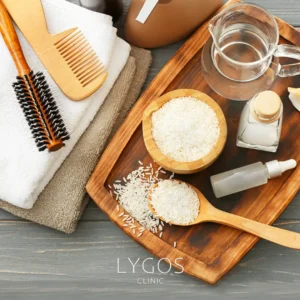Warts
Benign skin formations are called warts. This condition, which is caused by a certain group of viruses called HPV, can be seen in many parts of the body. Warts, which are more common on the hands, feet and face, can also occur in the genital and anal areas. This disease, which is encountered by people of all ages, is more common in children and adolescents. Warts that do not cause any harm are aesthetically disturbing. It can also cause complaints such as redness, pain and itching.
Choose Your Topic
Get in Touch
Get professional treatments in Turkey at Lygos Clinic, offering effective, affordable treatments for a healthier and more aesthetically pleasing life.
You can contact us via WhatsApp and Instagram for a quick response.

What is Wart?
Benign lesions caused by a virus called HPV are called warts. This condition, which occurs on the skin, is divided into more than one type. Warts, which occur on the mucosa as well as the skin, can be caused by direct or indirect contact. In particular, damage to the upper layer of the skin can lead to wart development.
Warts usually occur on the hands, face, mouth and genitals. The duration of this disease varies from a few weeks to a year, depending on the immune system of the person. Patients with warts may not have problems in other respects.
However, this may vary depending on the immune system and the cause of the disease. Diseases that cause immunosuppression, use of immunosuppressive drugs such as cortisone and organ transplantation increase the risk of warts. Many people develop warts that grow fleshy and painless. This growth, which is the main symptom of the disease, is usually more common in the organs that are interacted with.
What are Types of Warts?
Flat Warts
Verruca Vulgaris (Common Warts)
Genital Warts
The genital wart type is not always visible. Therefore, attention should be paid. They can also vary in color and shape. This type of wart is generally known to have a slightly darker appearance than skin color.
The upper part of the genital warts resemble the appearance of cauliflower. In addition, this type, which has a slightly raised shape, can occur in clusters or singly. In men; Genital wart type occurs in areas such as the penis, testicular skin, groin, thighs and around the anus.
In women, genital wart formation can be detected in the vagina, inside and outside the anus or in the cervix area known as the cervix. Types of warts that are invisible to the eye show themselves with complaints such as vaginal discharge, itching, burning and bleeding.
Plantar Warts
People with cracks on the soles of their feet develop warts more easily. The plantar warts first appears on the skin with a hollow center. This type, which manifests itself as a flat circular work around it, reaches a yellow colored and crusted appearance over time.
Some patients may also have a black area in the center of the warts on the soles of their feet. Patches containing salicylic acid are recommended for patients undergoing treatment to relieve the pain.
In addition, methods such as liquid nitrogen, curettage and laser treatment are also preferred for the treatment of warts on the soles of the feet.
Warts Treatment Methods
Although many warts types are not harmful to the body, they may need treatment. This disease, which disappears spontaneously without any treatment, can reach cosmetically disturbing dimensions. Especially warts that appear in the genital area need to be treated. The same is true for warts on the soles of the feet. So, how is wart treatment done? What are the warts treatment methods?
Some patients’ warts may start to cause damage. In such cases, treatment methods are used. Patients who seek treatment may experience bleeding or inflammation of their warts. In addition, the appearance of warts with other skin diseases and the emergence of the umbilical wart type may also require treatment. The formation of warts can accelerate with age. These warts can be confused with some types of skin cancer and you can contact your health care provider to make sure they are harmless.
It is very important that warts treatment methods are different from each other. These treatment methods that offer different solutions are determined according to the type, size, number and location of warts. Medicines containing salicylic acid solution are generally preferred in wart treatments.
Freezing method, also known as cryotherapy, and surgical procedures are also applied. The treatment, which is effective, inactivates the HPV virus in some people. Warts that do not recur directly affect the quality of life.
However, there is a risk of recurrence of warts due to the immune system in some people. Therefore, it is necessary to carefully follow the doctor's recommendations after treatment. Warts treatment methods are as follows:


Medicines Containing Salicylic Acid
Medicines containing salicylic acid should continue to be used for several weeks. These drugs, which are used more than once a day, are produced in forms such as cream and polish. Lactic acid is also preferred in some products. Warts treatment are also applied with band structures containing these substances. Care should be taken to apply the medicines regularly, which should be continued to be used with the doctor's control and approval.

Cryotherapy Treatment
The application of liquid nitrogen (nitrogen) to the warts are called cryotherapy treatment. The extremely cold liquid nitrogen destroys the cells in the upper skin layer. This treatment method, which can be applied in different ways, is usually done with a cotton swab. This stick dipped in liquid nitrogen is pressed on the wart. After continuing for a few seconds, the process ends. Cryotherapy treatment should be repeated at least once a week. It should be continued until the wart disappears. However, this treatment method may cause some side effects. Therefore, you should consult a specialist physician before treatment and plan the process together.

Surgical Treatment
In some patients, medication and cryotherapy may not be sufficient. In this case, surgical treatment may be required. During the procedure, anesthesia is applied to prevent the patient from feeling pain. After numbness is achieved, the wart is removed from the area by cutting it with scalpel or electrical surgical instruments. After surgical treatment, scarring may occur in the treated area. It should not be forgotten that the warts that many people encounter are not malignant and regress spontaneously within a few years. Therefore, you should avoid any damage to the area and you can prevent the spread in a short time by applying the right treatment method for you.

Are Warts Contagious?
Yes warts are contagious because of the HPV virus. This condition, which is transmitted through contact, is sexually transmitted in the genital area. Warts, which have been seen as a worldwide publication for centuries, have affected approximately 1 in 10 of the human population. This disease, which is more common especially in children, is also noticed in people who are engaged in meat work such as butchery.
Warts can also be more easily transmitted to people with a weak immune system. When we look at the distribution between the sexes infected by warts, it is seen that men and women are equally affected by the disease. Contact with these bumps on the surface of the skin can spread the disease. It is necessary to be careful against this situation, which is the most basic transmission factor. It should not be forgotten that warts caused by viruses such as HPV are highly contagious.
Warts can also be contagious through shared products such as towels or razor blades. Wearing the slippers of someone with warts on the soles of the feet can also become a problem. Warts are not always transmitted through contact. However, the probability of contracting the HPV virus is quite high.
Since everyone has a different immune system, the risk of infection varies accordingly. There is a time gap of 4 to 8 months between the infection and the appearance of the wart. This makes it easier to become infected if there is a wound on the skin. Therefore, wart viruses can be transmitted more quickly. Wet and damp skin also increases the risk of infection.
Warts are contagious and can occur in multiple ways, which can make them difficult to prevent. Therefore, it is critical to keep hands clean at all times, clean the skin wound and avoid contact with people who have warts.
A person can spread a wart from one part of their body to other parts of their body. To prevent warts from becoming contagious, the lesions should not be scratched. Care should be taken to keep the area dry, pay attention to the products used on the skin surface and avoid contact with the wart while shaving.
Herbs Good for Warts
Aloe Vera
Thanks to its ingredients, aloe vera gel provides relief in the applied area and accelerates healing.

Apple Cider Vinegar
Apple cider vinegar, which is used in many treatments, dries warts thanks to its acidic structure.

Chamomile
The anti-inflammatory properties of chamomile tea provide relief on the wart.

Garlic
Garlic is one of the plants that are good for warts thanks to its antiviral properties.

Onion
Another popular method is onion. Onions with antiseptic properties are known to be good for wart treatment.
Non-Surgical Warts Treatment
A person who wishes to undergo non-surgical warts treatment should consult a specialist doctor. If the patient’s condition does not improve without surgery, then this should be taken into account. However, electrocautery methods such as catherization can remove the warts without surgery. It should also be noted that mild disease can be cured with appropriate medication.
Non-surgical warts treatment is also available for the genital areas. This sexually transmitted disease can be solved with radiofrequency. Warts treatments, which are also treated by freezing, should be based on the needs of the patient and the most appropriate method should be chosen. As a result, non-surgical warts treatment eliminates the patient’s concerns with many methods.


Things to Consider in Warts Treatment
Because warts occur in many parts of the body, patients may avoid treatment. However, untreated warts in areas such as the genitals and soles of the feet can cause problems. Therefore, treatment may be necessary. However, this treatment process should be carried out by a specialized doctor.
Many methods are used in the treatment of warts. In particular, touching warts caused by the HPV virus can also cause contamination of different areas. Therefore, it is very important to choose the most appropriate method. Warts, which are usually benign, can rarely be malignant. Therefore, there are important things to consider warts treatment.
Drugs containing salicylic acid or lactic acid used as the first method should be used regularly and in a controlled manner. These drugs can be used to solve the problem before surgical intervention. Creams containing salicylic acid are applied to the wart area.
It should be applied within the time given by the doctor. Otherwise, irritation may occur in the area. The substances contained in the drugs used for several weeks may also cause allergic reactions. Therefore, a careful examination should be performed before treatment.
There are also cooling and surgical methods to be considered in warts treatment. In these methods, the doctor's recommendations should be followed to get the right information and get the best results after treatment.
Before-After Warts Treatment
You can understand the difference before and after warts treatment not only aesthetically but also with the disappearance of pain. In particular, the pain caused by warts on the soles of the feet and in the genital area may start to cause discomfort for a while. Therefore, you may need wart treatment.
Contact and sexual transmission of warts may also require treatment. Infection of the wounded areas makes it easier for warts to be transmitted. This can directly affect social and private life. As a result, the change that occurs before and after wart treatment also improves the quality of life.


Warts Treatment Costs
Costs may vary in warts treatment, where many methods such as medication, cooling and surgical intervention are applied. A person who first starts treatment with the use of medication cannot be expected to cover the same costs as a patient who will undergo surgical intervention. In addition, the quality of the drugs to be taken also affects the costs.
Warts treatment costs are also determined according to the patient’s recovery time. If a patient’s warts heal after a few weeks, they do not need to spend much. However, the same may be different for patients who require long-term treatment.
As a result, wart treatment costs are determined according to the needs of the patient. Since the needs of each patient are also different, giving a clear cost may mislead the person. You can get the most accurate and healthy information about the process by calling Lygos Clinic’s expert consultants.
| Warts Treatment |
Turkey |
ABD |
U.K. |
|---|---|---|---|
|
Warts Treatment Price |
$125 - $500 |
$270 - $850 |
$350 - $1,000 |
Get in Touch
Get professional treatments in Turkey at Lygos Clinic, offering effective, affordable treatments for a healthier and more aesthetically pleasing life.
You can contact us via WhatsApp and Instagram for a quick response.
Frequently Asked Questions About Eczema Treatment
BLOG

Is Breathing Through the Mouth Harmful?
Chose Your Topic Is Breathing Through the Mouth Harmful? Breathing is one of the most fundamental needs of life. However,

Does Rice Water Make Hair Grow? | Benefits of Rice Water
Chose Your Topic Does Rice Water Make Hair Grow? Natural methods in hair care have become quite popular in recent

Breast Lump | Types: Benign, Malign and Causes | LYGOS 2025
Breast Lump While cancer stands out as one of the most common health problems today, early diagnosis rates are also





